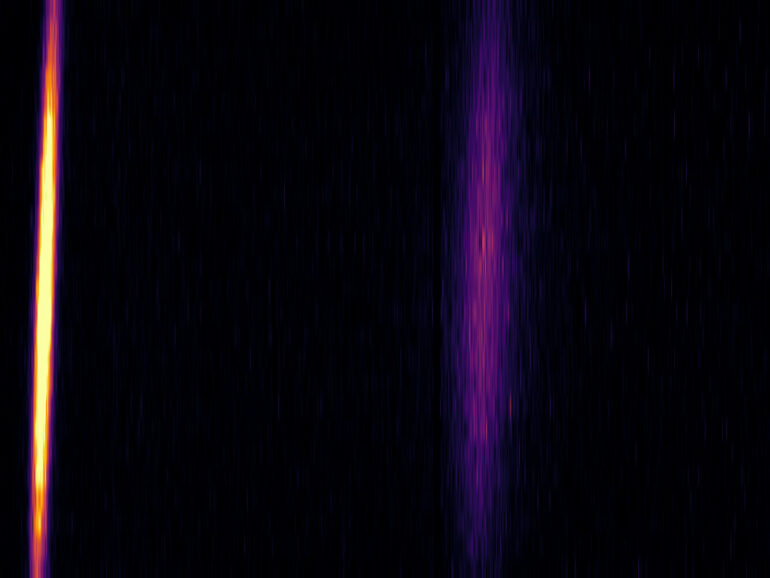Researchers at European XFEL have developed an innovative method to study warm dense matter with unprecedented accuracy. This kind of matter, that exists between condensed matter and plasma physics, can be found, for example, in astrophysical objects or is created during inertial confinement fusion.
For the contributing scientists at the Center for Advanced Systems Understanding (CASUS), this advancement is a great aid to their mission of lifting the analysis of warm dense matter onto a solid foundation. The study is published in Physical Review B.
Studying astrophysical objects is a major challenge. Extreme conditions prevail there: high temperatures and immense densities. Here on Earth, the same applies to the investigation of inertial confinement fusion capsules during the implosion phase.
At the High Energy Density (HED) instrument of European XFEL, these conditions can be prepared there using the powerful drivers provided by the HiBEF consortium (Helmholtz International Beamline for Extreme Fields). Coupled with the brilliant X-ray flashes of the European XFEL, scientists can now study this exotic state of matter more closely than ever before.
Warm dense matter: An exceptional phenomenon
We normally think of matter here on Earth as existing in either a solid, liquid or gaseous state. Further afield in space, matter existing as a plasma can also be discovered, characterized as a hot and ionized gas. However, at high temperatures and immense densities, like that found in stars or when meteors crash onto planets, matter cannot be easily described as solid, or as a plasma and is instead named warm dense matter.
Warm dense matter is too hot to be described by the physics of condensed matter and too dense for the physics of plasma. Typically, warm dense matter occurs at temperatures of 5,000 to several 100,000 Kelvin and pressures of several hundred thousand times greater than atmospheric pressure.
Discovery thanks to ultra-high-resolution X-ray Thomson scattering
A team led by Thomas Preston from the HED instrument at European XFEL has investigated the structure and properties of plasmons in ambient aluminum. Plasmons are collective oscillations of electrons and play a decisive role in the optical properties of metals, semiconductors, and in warm dense matter.
An important method to investigate excitations in solids as well as warm dense matter is X-ray Thomson scattering. Here an X-ray photon is scattered in the material and loses energy and momentum in exciting a plasmon. With a spectrometer, scientists can identify these photons that have lost energy from the main beam of X-rays that are just scattered elastically.
Differently to previous work, which could only measure these excitations with X-rays with poor resolution on the order of a few electronvolts, Preston’s team and contributing scientists from Helmholtz-Zentrum Dresden-Rossendorf (HZDR) as well as the HZDR institute CASUS have now recorded ultra-high-resolution X-ray Thomson scattering spectra with an energy resolution improved more than tenfold meaning that they reached a resolution of less than one hundred millielectronvolt.
As the team reports, the new setup enabled the investigation of the structure and properties of plasmons in aluminum in detail.
“We realized that we could repurpose an existing setup that was designed to make even higher resolution measurements of vibrations in solids, which have energy losses much smaller than scattering from a plasmon, in fact only a few tens of millielectronvolts,” explains Preston.
“Through a clever choice of our X-ray energy, we can instead measure energy losses up to 40 electronvolts with similar resolution. The accuracy of our measurements made it possible to eliminate long-standing discrepancies between simulations and experimental observations,” says Preston.
In future work, the team intend to use this method to benchmark simulations for plasmons at higher temperatures and compressions.
Future prospects
“These exciting new capabilities at the European XFEL allow for unprecedented insights into the behavior of matter at extreme conditions,” explains lead author Thomas Gawne from the Young Investigator Group “Frontiers of Computational Quantum Many-Body Theory” led by Tobias Dornheim.
Dornheim plans to make X-ray Thomson scattering evaluation accessible beyond the small group many-body system simulation experts. If he succeeds, laser physicists at European XFEL and elsewhere could design their experiments in a more targeted manner than it is possible today.
Thomas Preston highlights the possibilities of collaborations with theoretical groups, in particular with the CASUS scientists, saying, “The unique combination of cutting-edge theory at CASUS and HZDR as well as the state-of-the-art experiments at the HED instrument at European XFEL opens up completely new possibilities for science. The relationship between measurement and simulation is critical to be able to drive and inform exciting new experiments.”
For him, this joint effort is not only relevant for the investigation of warm dense matter conditions in astrophysical objects, but also for research into inertial confinement fusion, a promising avenue of power generation based on nuclear fusion reactions that could eventually become a climate-friendly and virtually inexhaustible source of energy.
More information:
Thomas Gawne et al, Ultrahigh resolution x-ray Thomson scattering measurements at the European X-ray Free Electron Laser, Physical Review B (2024). DOI: 10.1103/PhysRevB.109.L241112
Provided by
Helmholtz Association of German Research Centres
Citation:
European researchers reach unmatched level in measurements of matter under extreme conditions (2024, July 11)



